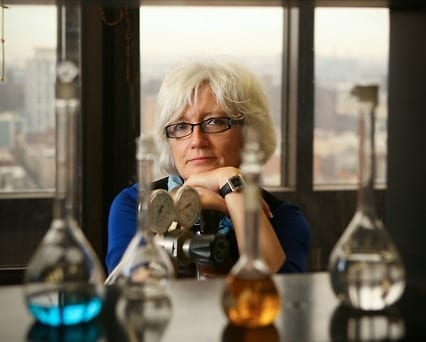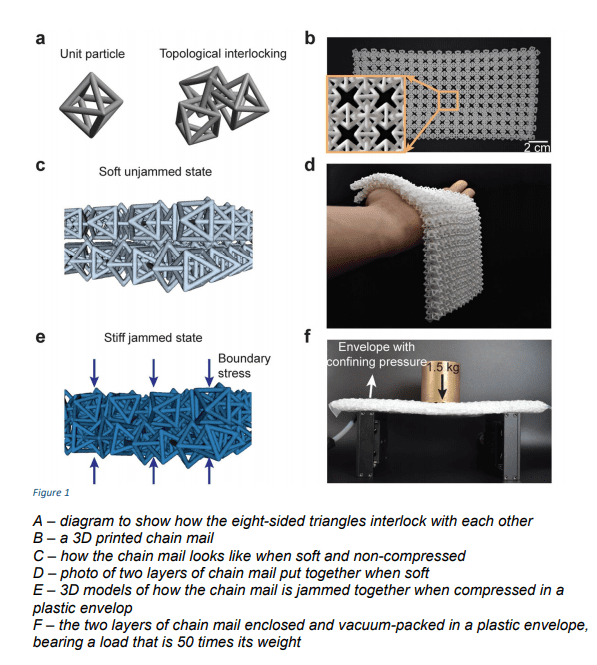
From the lab of City College of New York chemical engineer and Fulbright Scholar Teresa J. Bandosz comes a groundbreaking development with the potential to thwart chemical warfare agents: smart textiles with the ability to rapidly detect and neutralize nerve gas.
The fabric consists of a cotton support modified with Cu-BTC MOF/oxidized graphitic carbon nitride composites. The latter were developed in the lab previously and tested as nerve agent detoxification media and colorimetric detectors.
Combining Cu-BTC and g-C3N4-ox resulted in a nanocomposite (MOFgCNox) of heterogeneous porosity and chemistry. Upon the deposition of MOFgCNox onto cotton textiles, a stable fabric with supreme photocatalytic detoxification ability towards the nerve gas surrogate, dimethyl chlorophosphate, was obtained.
The detoxification process was accompanied by a visible and gradual color change, which Bandosz said can be used for the selective detection of chemical warfare agents and for monitoring their penetration inside a protective layer.
“These smart textiles adsorbed almost 7g of CWA surrogate/its detoxification products per gram of Cu. The superior performance was linked to the high dispersion of the MOF crystals on the fibers, and a specific texture promoting the availability of the active copper centers,” said Bandosz, who is seeking funding for additional research.
Learn more: City College researchers produce smart fabric to neutralize nerve gas
The Latest on: Smart fabric
[google_news title=”” keyword=”smart fabric” num_posts=”10″ blurb_length=”0″ show_thumb=”left”]- Automotive Fabrics Market to Reach $62.22 Billion by 2033; Rising Demand for Vehicle Interior Aesthetics to Propel Growthon May 7, 2024 at 5:00 pm
The global Automotive Fabrics market is anticipated to grow from USD 38.71 billion to USD 62.22 billion in 10 years. The advancement of safety measures in automotive applications has significantly ...
- M&S shoppers love £39.50 trousers that are 'very smart' and 'don't crease'on May 7, 2024 at 1:31 pm
The Crepe Tab Detail Wide Leg Trousers from M&S have been designed in short/petite, regular and long lengthways ...
- Walmart’s Google-powered streaming box and smart speaker combo is liveon May 7, 2024 at 12:43 pm
W almart has listed its new “Pro” Google TV streaming box / smart speaker combo a week after the product leaked into the real world and intermittently appeared on the store site.
- How to Accelerate AI-Driven Decision Intelligence with Smart Data Fabricon May 6, 2024 at 6:57 pm
Join the upcoming webinar to learn how a smart data fabric can be used to unify data across disparate sources and accelerate AI-driven decision intelligence.
- Dress green: Take a look at summer's top eco-friendly fabricson May 3, 2024 at 3:47 am
These eco-friendly fabrics are crafted to reduce ecological harm, utilizing significantly less water and fewer chemicals compared to their conventional counterparts, marking a positive step for both ...
- Here's how you can ace smart casual with chinoson May 3, 2024 at 1:02 am
Combine your chinos with a neatly pressed button-down or a sleek polo shirt for a classic smart casual appearance. Ensure the shirt is tucked in and complement it with a leather belt to accentuate the ...
- Walmart's Game-Changing 4K Chromecast Smart Speaker Combo Unveiled Ahead of Official Launchon May 1, 2024 at 9:10 pm
Walmart's upcoming device combines the functionality of a high-resolution streaming device with the convenience of a smart speaker, offering users a comprehensive entertainment solution.
- Walmart is about to launch a 4K Chromecast that’s also a smart speakeron May 1, 2024 at 5:16 pm
Walmart is apparently getting ready to release a new Onn “Pro” Google TV 4K streaming box that’s also a smart speaker. Yesterday, YouTuber Superdell-TV hosted a livestream where he showed off the ...
- ‘Smart Casual’ Is Menswear’s Most Dominant Dress Code. Here’s How to Nail It.on April 28, 2024 at 6:00 am
Menswear expert and book author Simon Crompton breaks down how to dress "casual chic" via well-tailored essentials, pairings, and more.
- This is the best smart accessory you didn’t know you neededon April 27, 2024 at 2:40 am
The Nix Mini 2 is a smart, portable color wizard that scans colors in the real world and transposes them to digital formats. It syncs with your mobile devices.
via Google News and Bing News










